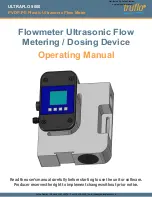
Pulse Pro
fi
ling Application
Internal Manual Level
: You must set the trigger level manually. The trigger is
based on the input signal as it crosses the level you specify. If you set the trigger
level too high, then you will not get a trace. Instead, you will get a “Trigger?”
message in the middle top of the Measurement grid. This message indicates that a
trigger was not found. If the trigger is set too low, then the system will trigger on
noise. A trigger pulse is sent out the TTL trigger output each time a sweep starts.
External TTL
: The instrument will take a measurement after it senses a transition
on the TTL trigger input (TI). To use this trigger function, connect an SMB
cable to a TTL trigger source. Use this capability to trigger on very low signal
levels approaching the noise
fl
oor of the instrument. For measuring very low
signal levels, use the Averaging and Filters functions. (See page 40,
NOTE.
An incoming pulse for an external TTL trigger must be on at least 0.20
μ
s
followed by at least 1
μ
s of off time for the sensor to properly trigger.
Trigger Level.
Use this menu function to set the trigger level when the trigger
source is set to Internal Manual Level.
Edge.
Use this menu function to set the instrument to trigger on a positive or
negative edge.
Continuous.
Use this menu function to set the instrument to continuously provide
a new trace with each new trigger event.
Single Sweep.
Use this menu function to set the instrument for a single sweep.
The instrument will then wait for a trigger each time the Single button is clicked.
Single.
This button is blue when Single Sweep trigger is active. Click this button
to initiate a trigger sequence.
Delay Trigger.
Use this menu function to delay the beginning of a trace from the
trigger event for up to 10 ms. This may be used to capture high resolution traces
long after the trigger event.
Trigger Out.
Use this menu function to enable the TTL trigger output (TO) signal
and invert it.
Timeout.
Use this menu function to set a timeout period for an external trigger
input (up to 10 seconds). If a trigger event is not detected in the allotted time, the
system will time out and the
Trigger?
indicator will appear at the top center of
the Measurement Trace window.
NOTE.
If the trigger timeout is set long, and triggers occur slowly, the meter
display will appear sluggish as the instrument waits for triggers.
RF and Microwave Power Sensors/Meters
39
Summary of Contents for PSM3000 Series
Page 2: ......
Page 6: ......
Page 10: ...Table of Contents iv RF and Microwave Power Sensors Meters...
Page 14: ...Preface viii RF and Microwave Power Sensors Meters...
Page 26: ...Getting Started 12 RF and Microwave Power Sensors Meters...
Page 32: ...Operating Basics 18 RF and Microwave Power Sensors Meters...
Page 74: ...High Speed Logger Application 60 RF and Microwave Power Sensors Meters...
















































